Work Party Dates:
July 10th -6 pm
August 8th – 6 pm
September 11th – 6 pm
Updates:
Update of record for 31st July.
Update of record on 26th July in relation to Egyptian Geese
Photographs added 17th and 25th July 2018
Photograph added: 16th July 2018
Photograph added 5th July 2018
31 July 2018
Heavy showers at dawn, clearing to sunny intervals on a south-westerly wind.
Whilst the margins of Railway Pool were generally quiet, there was plenty of warbler activity around Railway Hide with two Common Whitethroats showing well on the embankment and a Lesser Whitethroat calling in the adjacent scrub, along with a Blackcap. There were also at least two Blackcaps calling in the back gate compound along with Reed Warblers there; and, finally a Sedge Warbler in the Reedbed. A Brown Hawker was sunning itself on the Guelder Rose by Railway Hide.
On Car Park Pool there were three Little Egrets, three Green and two Common Sandpipers, three Oystercatchers, two Little Ringed Plovers and a Snipe.
There are still at least two unfledged Black-headed Gulls on site, one on the Car Park Pool islands and one on the largest of the Tern rafts. Common Terns continue to bring in fish to both fledged and unfledged juveniles. A Red Kite went over in the evening.
Reed Warbler activity today was again marked around the north causeway bay and at least one of the young Cetti’s Warblers showed well as captured by Max Silverman’s excellent picture.
Cetti’s Warbler – photograph by Max Silverman
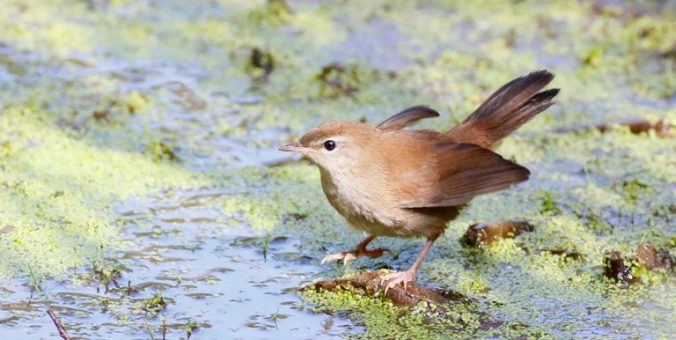
The dry weather has had an impact on the trees and bushes with Silver Birch, Rowan, Alder and some Hawthorn all looking rather sad. Whether they are just shedding leaves early and will recover next year remains to be seen.
Brambles seem completely unaffected by the drought and there is a good early crop of blackberries developing.
30th July 2018
Sunshine and showers on a blustery south-westerly wind.
With decreasing water levels and a muddy margin, it is not surprising that the Dragonfly Pond has become attractive to Green Sandpipers and there were four today including three nicely captured in the photograph by John Hunt (see below).
Green Sandpipers – Photograph by John Hunt
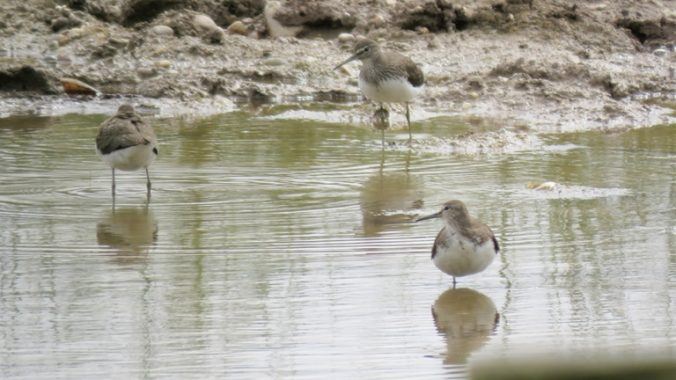
A further Green Sandpiper was on Car Park Pool along with a Common Sandpiper and a Snipe and a further Common Sandpiper on the margins of Railway Pool. In the north causeway bay there were a number of Reed Warblers, including a family party, and a single juvenile Water Rail. At least three Chiffchaffs called along the Old Road and 19 Swallows went through in a single flock at 9.15. By the south-west pond a Reed Warbler was seen feeding a juvenile Cuckoo, seemingly the second one of the year to be bred on site.
At least ten Greenfinches and eight Goldfinches, along with 12 Starlings and good numbers of young of Blue and Great Tits were feeding on the seed at the Car Park feeder and there was a Great Spotted Woodpecker at the Oak Hide feeder.
In the evening, a few Sand Martins came in to feed, seemingly on their way south. There were at least 13 Common Terns as well.
29th July 2018
A further drop in temperatures on the back of a strong south-westerly wind with wet and windy weather for most of the morning, slowly relenting into the afternoon.
The Whooper Swan was back on Car Park Pool and Shoveler numbers had increased to nine, but there was only one Little Egret early morning. Three juvenile Shelduck were still on site along with two juvenile Little Ringed Plovers and at least four Common Sandpipers.
A particularly boldly marked Snipe was also of interest. The bird was very black headed and backed with marked contrasting white tramlines and russet (with pink tones) face, neck and upper breast and an extremely bright rusty tail. The bill was also noticeably pink based extending approximately half to two thirds of the way along to the tip. Is this one of the Faeroese type birds ?
There were still six adult, eight fledged and two unfledged Common Terns and despite the blustery wind, a Sedge Warbler called from in front of River Hide, young Reed Warblers were noisy on the causeway, one or two Chiffchaffs and Blackcaps also called and a flock of 40 Starling were kept on their toes by a male Sparrowhawk. A juvenile Song Thrush fed along the central streamline showed well in the causeway channels.
Other birds today included an adult Water Rail in the Marsh from Oak Hide and two juvenile Water Rails in the channels viewable from the north causeway hide.
Teal numbers had increased to 13 and there were single Green Sandpipers on both Railway Pool and Car Park Pool.
Bullfinches have been either unobtrusive, thin on the ground or under recorded so it was pleasing to note that there were two juveniles in the back gate copse today.
28th July 2018
Noticeably cooler with temperatures down about 15 degrees from 30 to 15 degrees centigrade. A blustery south, south westerly wind with initially sunny intervals and very occasional light showers, rain becoming heavy and protracted mid-afternoon.
The more notable birds today included eight Little Egrets, two Snipe, three Oystercatchers (two adults and the colour-ringed juvenile from Marsh Lane), three juvenile Little Ringed Plovers, five Common and one Green Sandpiper, 20 Common Terns (12 adults, eight juveniles and two chicks still using one of the Tern houses) and some notable hirundine movement.
In the early morning at about 7 am one to two Sand Martins began to appear and, at any one time, an hour later, this number had built up to 12 with a further ten feeding in the lee of the trees to the south of Patrick Farm. At 9.30 am House Martins began to appear with at least five at any one time and six Swallows went south. Five Swifts put in a brief appearance.
Slightly out of season for the Reserve a flock of 14 Herring Gulls went south at approximately 9 am and they were very noisy and were mostly adults.
Other birds today in the usual wildfowl count were as follows: 14 Mutes, 228 Greylag / Canada Cross, 26 Canadas, three juvenile Shelduck, a drake Wigeon, 45 Mallard, ten Teal, two Shoveler, 25 Gadwall and seven broods, 26 Tufted and 21 broods, 17 Moorhen and the new brood in the Marsh, 84 Coot, seven Little Grebe plus a new youngster in the north causeway bay, seven Cormorants, two Great Crested Grebes, three Herons, 49 Lapwing, 40 Black-headed Gulls with one or two late lingering juveniles and at least three Lesser Black-backs.
27th July 2018
Humid, sunny but with some cloud but still hot.
The three juvenile Shelduck were still present on Car Park Pool today and one of yesterday’s Black-tailed Godwits remains. There were also singles of Green and Common Sandpiper and three Little Egrets.
26th July 2018
Sunny and hot.
Two Black-tailed Godwits arrived today, as two separate individuals and, in addition, the three juvenile Shelduck remained, along with two Little Ringed Plovers, a Common Sandpiper and three Little Egrets. The report of three Egyptian Geese related to the three juvenile Shelducks.
25 July 2018
Sunny and hot.
A more diverse selection of birds today included both Common and Green Sandpiper, Ringed Plover and two juvenile Little Ringed Plovers, six Little Egrets, three Shelduck, an adult Peregrine, a family of four Green Woodpeckers and the Whooper Swan.
Other wildfowl included 13 Mute Swans, a drake Wigeon, one Shoveler, four Teal, nine Gadwall broods (43 ducklings) and 24 Tufted broods of 94 ducklings.
The juvenile Cuckoo was again seen around Railway Hide and, away from birds, there were three Purple Hairstreaks by the back gate copse and also a Southern Hawker there.
White-letter Hairstreak (egg) – Aeromodellers Wych Elm – Photograph by John Hunt
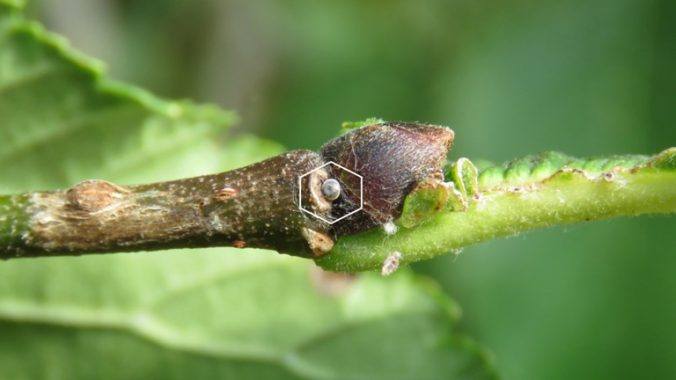
24th July 2018
Generally warm and sunny though some cloud and noticeably cooler from the north west in the evening.
The three juvenile Shelducks were still on site today and there were also two Common Sandpipers, one on each pool.
12 Greenfinches at the Car Park feeder were of note and included younger birds, presumably bred on site.
The Whooper Swan was back on Car Park Pool this evening having left Packington.
23rd July 2018
Warm and sunny, though slightly cooler from the north west.
Three juvenile Shelducks were new in today and there were four Little Egrets on site. Five Swallows were noted over Car Park Pool which is relatively unusual at this time of year and suggests that they are probably early migrants.
22nd July 2018
Overcast with occasional sunny intervals in the morning, sunny and bright, with a light north-westerly wind pm.
Today’s highlight was a frustratingly brief visit from a partial summer plumaged Spotted Redshank, seen from Oak Hide in the early morning, but it did not linger.
There were two Green Sandpipers on site today, one around Railway Pool and then a second at Patrick Bridge. Common Sandpipers had increased to four and Little Egrets to six. A juvenile Cuckoo showed well on a number of occasions around Railway Pool, initially in the gorse clump next to the path by Railway Hide and then later in the back gate copse.
At least two Nuthatch and a Treecreeper were along the Old Road and other counts today included 154 Greylags, 27 Canadas and 18 Common Terns (nine adults and nine juveniles) plus a still to fledge chick.
The Cetti’s Warbler family was vocal on the east side of the Reedbed and there were a number of young Reedwarblers both in front of Oak Hide and along the causeway. The Blackcap was still in song by Railway Hide.
In Siden Hill Wood a mixed Tit and Warbler flock included at least two fledged Treecreepers, two fledged Goldcrests, a calling Nuthatch, a calling Coal Tit; and there was Green and Great Spotted Woodpecker also in the wood plus a signing Stock Dove at the south end and two Buzzards there in the cleared area.
On the flood plain there were 235 Jackdaws, 14 Common Crows and around Patrick Bridge at least four Sand Martins, two House Martins and three Swallows. At the farm there were at least five young House Sparrows.
Butterflies included Purple Hairstreak and ten Speckled Woods in Siden Hill Wood, Peacock and Comma on the flood plain; and, on the Dragonfly Pool along with many small Red-eyed Damselflies were two Emperor Dragonflies, one of which was ovipositing.
One of the young Common Terns ringed this year (on the 21st June) has just been seen almost exactly a month later at Seaforth Nature Reserve, Merseyside. C22 was seen there on the 22nd July, 91 miles to the north and, to be honest, was not a direction that we were expecting.
21st July 2018
Mostly overcast, sunny intervals, light north-westerly wind.
The more interesting birds today included one adult and four juvenile Little Ringed Plovers, a Common Sandpiper, a Green Sandpiper at Patrick Bridge, 27 Common Terns (17 adults and ten juveniles) and an increase to an impressive thirty broods of Tufteds. In a good year for Purple Hairstreaks one was seen in the crop field oaks and around the Dragonfly Pool there was one Emerald Damselfly and at least 15 small Red-eyed Damsels.
Other counts today included 13 Mute Swans, 36 Greylags, a drake Wigeon, one Teal, 59 Mallard, 21 Gadwall and nine broods of 46 ducklings, 37 Tufted and 30 broods of 160 ducklings, five Herons, six Cormorants, two Great Crested Grebes with a new nest between the Marsh and the gravel spit, containing one egg, two adult and two juvenile Little Grebes, 16 Moorhens, a juvenile Water Rail in the causeway channels, 80 Coots, 45 Lapwing, two Oystercatchers, 105 Black-headed Gulls, five Lesser Black-backed Gulls, at least one juvenile Cetti’s Warbler along the causeway and 20 Swifts over Siden Hill Wood.
Other butterflies included two Red Admirals and at least four Large Whites.
20th July 2018
Sunny intervals and cloud, light north-westerly wind.
A Dunlin was the only new arrival today. The supporting cast included two Little Egrets, two Little Ringed Plovers and a Common Sandpiper together with a single Water Rail in the channels of the north causeway bay.
Water Rail – 20th July 2018 north causeway bay – photograph by Max Silverman
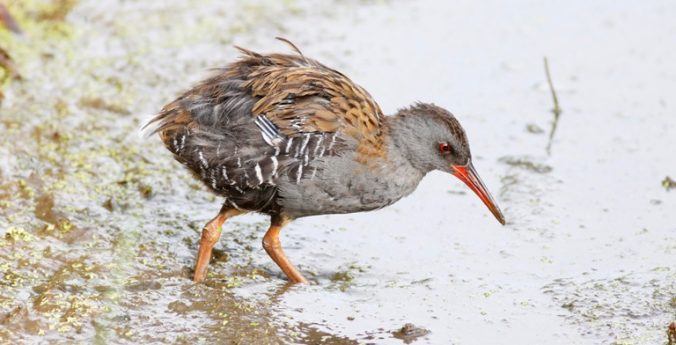
The Dunlin was still present in the evening on the Car Park Pool islands, along with 18 Common Terns of which 12 were juveniles.
The Cetti’s Warbler family was active and noisy around the central streamline until they were spooked by a Muntjac jumping across the stream and barking just underneath then.
Reed Warbler – 20th July 2019 – Photograph by Max Silverman
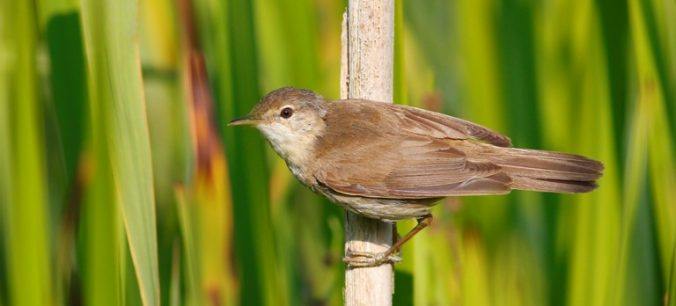
19th July 2018
Still warm and sunny but with some cloud and a slight easing of temperatures.
Two Little Egrets, two Oystercatchers and a drake Wigeon were viewable from Oak Hide this morning and a female Teal was also visible there, later on. The Whitethroat pair continued to show well by Railway Hide.
18th July 2018
Warm, overcast.
There were 16 Terns on the Car Park Pool islands today of which nine were fledged juveniles. There was also a Common Sandpiper and at least 15 Starlings, the majority of the latter being this year’s birds.
Around the car park there were two family parties of Goldfinches with at least two juveniles between them and a Red Admiral was on the mud in front of Car Park islands.
The evening counts were as follows: 186 Greylags, 16 Mute Swans and five cygnets, the Whooper Swan and drake Wigeon, ten Gadwall broods of 51 ducklings, 22 Tufted broods of 99 ducklings, an adult and three juvenile Little Grebes, three Great Crested Grebes, a single Little Egret, seven Cormorants, three Common Sandpipers, a Little Ringed Plover, two Oystercatchers and 32 Common Terns of which 14 were adults, 16 were juveniles and two were relatively new chicks.
There was also a Painted Lady between Oak Hide and the south-west pond.
17th July 2018
Sunny, warm, light westerly.
There were at least four Little Egrets on site today along with four Little Ringed Plovers, a Common Sandpiper, two Teal, two adult Herring Gull and at least three Green Woodpeckers. The Whitethroat pair continued to show well in front of Railway Hide.
Cows in the river by Patrick Bridge and showing the drier and damp areas of grass – Photograph by Nick Barlow – 17th July 2018
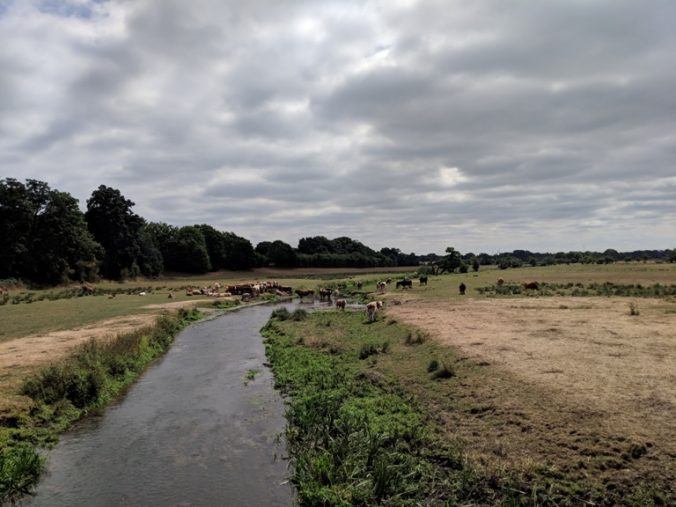
16th July 2018
Sunny, slightly cooler westerly.
Migrant waders in today included three Redshank, four Little Ringed Plovers and a Common Sandpiper.
On or over the flood plain were three Swifts, two Swallows, two Sandmartins, a Rook, 16 Canadas and 25 Greylags.
From the north causeway screen, a juvenile Water Rail showed well along with at least three Reed Warblers.
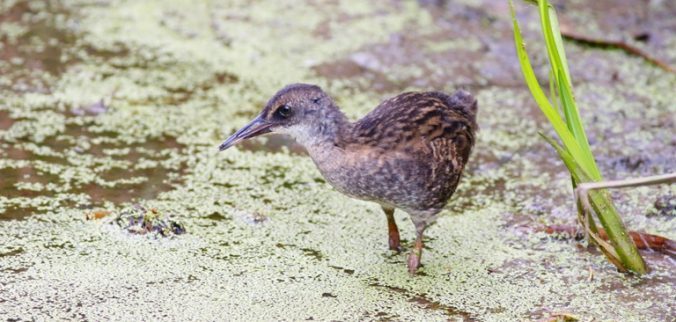
Juvenile Water Rail in front of North Causeway Screen – 16th July 2018 – Photograph by Max Silverman
The car park feeder continues to attract plenty of birds including three Stock Doves, four Greenfinches, five each of Blue Tit and Great Tit, a Goldfinch, two Reed Buntings, a Dunnock and two Moorhen and two chicks.
A Small Copper showed well on the muck heap.
15th July 2018
Hot and sunny.
The first Greenshank of the year spent most of the day feeding in the shallows west of the Car Park Pool islands where it was intermittently joined by two adult Little Ringed Plovers and a Common Sandpiper. Four Little Egrets roosted on the gravel bar on Railway Pool and amongst the other birds seen today was a small collection of hirundines over the Aeromodellers. This included at least four Sand Martins, three juvenile Swallows and two House Martins.
Adult Common Terns were still bringing in fish to at least eight fledged juveniles and the Cetti’s Warbler family was calling by River Hide.
In the warm weather there were plenty of butterflies including at least three Peacocks and a Marbled White, with one White-letter Hairstreak visible on the Wych Elm by the Aeromodellers steps where there was also a Comma. In the Old Road game crop a Banded Demoiselle showed particularly well and there was a Brown Hawker on Dragonfly Pool.
Late morning there was a brief visit from a juvenile Mediterranean Gull. Common Sandpiper numbers increased to three, Little Egrets to five and wildfowl included the long staying drake Wigeon, three Shoveler, four Teal, a creche of at least 25 Tufted ducklings with two Gadwall ducklings amongst them (but only one female Tufted in attendance), a Gadwall brood of seven, with four Tufted amongst them, and lastly there was a Coal Tit in the crop field oats.
Many thanks to Mike Hearn and John Hunt for running the website with Kay Gleeson during late June and early July.
14th July 2018
Hot and sunny.
Three Black-tailed Godwits were the first of the autumn with one on Car Park Pool and two on Railway Pool. There were also three Little Ringed Plovers and two Common Sandpipers.
There was an adult and a juvenile Water Rail seen in the newly cleared channels along the causeway, four Little Egrets, 29 Common Terns, a Hobby, at least two Cetti’s Warbler calling along the central stream and a Green Sandpiper at Patrick Bridge.
Aside from this there were 16 Mute Swans and five cygnets, 87 Greylags, one Canada, a drake Wigeon, 35 Mallard, 24 Gadwall and ten broods, four Teal, 26 Tufted and 21 broods, four Little Grebes, three Oystercatchers, 47 Lapwing, 14 Moorhen, 75 Coot, two Herons, eight Cormorants, 100 Black-headed Gulls, seven Lesser Black-backed Gulls and two Great Crested Grebes.
13th July 2018
Slightly cooler but remaining warm and sunny.
Aside from an impressive seven Little Egrets there were just two Common Sandpipers and a lingering drake Wigeon.
12th July 2018
Remaining hot and sunny.
There were two Little Ringed Plovers on Car Park Pool along with the usual collection of Terns, Gulls and Waders. In front of Oak Hide there were two Common Sandpipers, three Little Egrets and two Oystercatchers with Reed Warbler and Water Rail on view from the causeway. Seven Swifts went over.
11th July 2018
Warm and sunny.
Today’s highlight was undoubtedly the proof that Cetti’s Warblers had bred again on the Reserve. Three newly fledged young were seen on the path to River Hide.
Other cumulative counts today were as follows: 15 Mute Swans and five cygnets, the Mallard brood of five on Railway Pool, ten Gadwall broods with 64 chicks in total, one drake Wigeon, six Teal, an impressive 26 Tufted broods (137 chicks including a brood of 29 plus two Gadwall), 15 Common Terns (eight adults and seven juveniles), three Little Egrets, two Common Sandpipers, three Stock Doves, two Buzzards over Siden Hill Wood, both Common and Brown Hawker, Ringlet, Peacock, Small Skipper and Marbled White.
10th July 2018
Slightly cooler, but dry and sunny, light north-easterly wind.
The Whooper Swan was still present again today though it has been seen up on the lakes in Packington Park. There were also 18 Mutes, a drake Wigeon, three Teal, at least ten Gadwall broods including one with two Tufted ducklings. There was also a drake Pochard on Car Park Pool. 20 Tufted broods was a good count including one of 15 which contained two Gadwall ducklings.
Other birds included two Little Egrets, two juvenile Water Rails from a successful breeding in the causeway, four Oystercatchers, one Little Ringed Plover, one Common Sandpiper, 16 adult Common Terns and ten juveniles, a Nuthatch along the Old Road and 83 Lapwings including 60 on the flood plain.
Seven attended the Work Party in the evening and achieved a lot of useful work including mowing, strimming, Alder and Willow cutting back / removal, Ragwort clearance and general visibility improvements. Thanks to all those who attended.
9th July 2018
Hot and sunny.
No records.
8th July 2018
Sunny and very warm. Light NNW
The star bird of the day was the first returning Ruff of the season, a male which stayed until around 1230, having arrived earlier in the morning and been seen by several observers. The run of Common Sandpiper records continued, with one on each pool during the morning, and there were also up to three Little Ringed Plovers on Car Park Pool during the day.
There is plenty of evidence of continuing nesting activity across the Reserve with Sedge Warbler seen attending a nest near Oak Hide, Whitethroat feeding young in a nest by Railway Hide and Reed Bunting with young close to River Hide.
Other records of note included a large number of Jackdaws, initially 150+ on the Flood Plain, later rising to some 300-400, both Green and Great Spotted Woodpecker, Treecreeper in the hedge behind Oak Hide and two Ravens over Siden Hill Wood.
7th July 2018
Sunny and very warm. Light NNW
The weekly count across the pools, combined with other records, was as follows: 14 Mute Swans with five cygnets, the long-staying Whooper Swan, 63 Greylag Geese, 23 Gadwall + 14 broods totalling 60, female Teal, male Wigeon, 20 Tufted Duck + 15 broods totalling 67, two Little Grebes with a juvenile (Reedbed), two Grey Herons, two Little Egrets, six Cormorants, six Moorhen, 65 Coot, 41 Lapwing, three Oystercatchers, up to four Little Ringed Plovers, two Common Sandpipers, a Water Rail with two juveniles (Causeway) and 27 Common Terns plus 13 juveniles. Gull numbers were 250 Black–headed and three Lesser Black–backed.
Butterfly records were five Purple Hairstreaks (Old Road (3) + Aeromodellers (2)), a White–letter Hairstreak (Aeromodellers) and a Holly Blue (Old Road).
6th July 2018
Sunny and very warm. Light NW
Records from the pools were four Little Ringed Plovers, two Common Sandpipers, two Little Egrets and two Ravens over. Two Purple Hairstreaks were seen in Siden Hill Wood, along the path to Tower Hide
5th July 2018
Sunny throughout and very warm. Light NNE
Car Park Pool held three returning Common Sandpipers in the morning, along with three Little Ringed Plovers and a Little Egret. The first Water Rail sightings for a while were of an adult and juvenile from the Causeway hide with an immature also seen from Oak Hide. Other records included a Hobby hunting overhead and, along the Railway Embankment, two Whitethroats.
Purple Hairstreaks were much in evidence with nine in total, eight of which were along the Old Road between the Car Park and the Concrete Road, while the other was seen in the marsh on the north side of the Causeway. Other butterfly records were of 12 Marbled Whites and a single Essex Skipper.
Highlights from later in the day were up to four Common Sandpipers (possibly two on each pool), 60+ Sand Martins which passed through, five Oystercatchers, one of which was a near-adult, and a pair of Great Crested Grebes, with a youngster, on Car Park Pool.
Juvenile Water Rail – from North Causeway Screen – Photograph by John Hunt – 5th July 2018
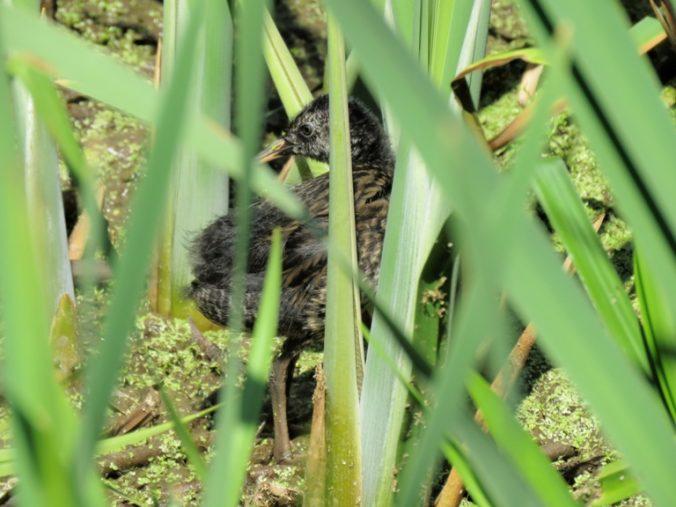
4th July 2018
Very warm and sunny throughout the day. Light N
A mid-week count produced the following: 15 Mute Swans with five cygnets, 57 Greylag Geese with 29 young, a male Shoveler, two male Teal, eight Gadwall broods totalling 44 plus three adopted Tufted ducklings, 14 Tufted Duck broods totalling 78, four Great Crested Grebes in total with a pair nesting on Railway Pool, two Little Grebes with one juvenile, two Little Egrets, a Little Ringed Plover, 12 Common Terns with eleven chicks and, finally, two Oystercatchers with a single chick on Car Park Pool.
3rd July 2018
Sunny throughout the day and very warm. Light NE
The first returning Common Sandpiper was on Car Park Pool this morning, together with two Little Ringed Plovers.
The other record of note was a Purple Hairstreak which was found in the Oak on the edge of the Old Road, just south of the dung heap in the field between the road and the river.
2nd July 2018
Sunny throughout the day and very warm. Light NE
There was quite a lot of activity around the Car Park, with Green Woodpecker, Chiffchaff, Goldfinch, Reed Bunting, Great Tit, Blue Tit and Chaffinch all noted and a male Kestrel hunting. Elsewhere, there were two Buzzards over Siden Hill Wood, four Stock Doves from River Hide and a group of some 70 Jackdaws was on the Flood Plain.
Finally, 12 Green–veined White butterflies were noted on a patch of mud in the Marsh.
1st July 2018
Very warm all day. Sunny during the morning/early afternoon but clouding over later. Very light NE
The combined results of this week’s count across the pools and other logbook entries during the day were as follows: 16 Mute Swans with five cygnets, the long-staying Whooper Swan, 36 Greylag Geese, 22 Gadwall + five broods totalling 29, male Teal, male Wigeon, m+f Pochard, 22 Mallard, 30 Tufted Duck + twelve broods totalling 65, four Little Grebes with a juvenile and a new brood of three, two Great Crested Grebes, four Grey Herons, Little Egret, four Cormorants, five Moorhen, 58 Coot, 60 Lapwing, three Oystercatchers with a fledged colour-ringed juvenile and one chick, up to four adult and two juvenile Little Ringed Plovers (the juveniles possibly from elsewhere) and up to 23 Common Terns plus 18 juveniles. Gull numbers were 200 Black–headed with 215 chicks and four Lesser Black–backed.
Other records across the Reserve included three raptor species: Buzzard from Railway Hide, Sparrowhawk from River Hide and Hobby hunting over Car Park Pool. A Whitethroat was singing along the Railway Embankment with Chiffchaff likewise around the Lorry Park in the early evening. Both Green Woodpecker and Great Spotted Woodpecker were seen, the former around the Back Gate and the latter between Oak and Railway Hides.
Finally, an amusing family dispute was observed between two adult and two juvenile Black–headed Gulls over the ownership of a fish – the youngsters kept dropping it until, after 5-6 minutes, one of the adults lost patience, picked it up and flew off!
